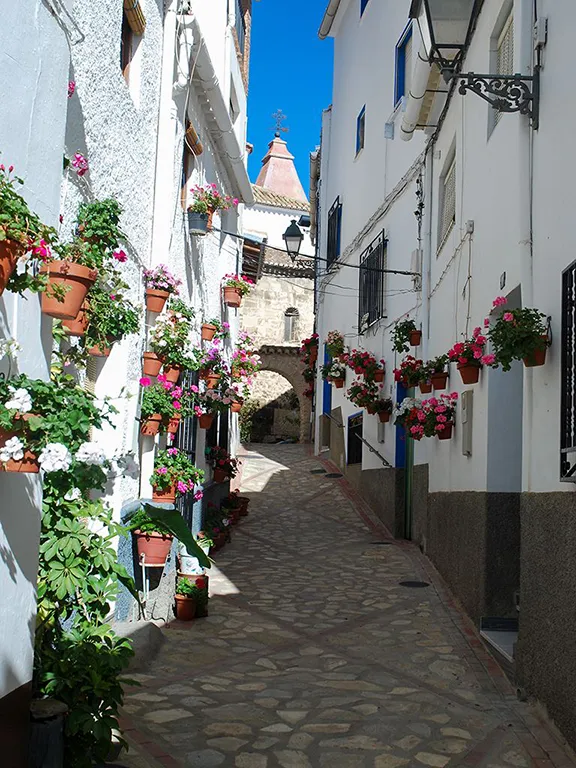Castril is perched on the southern flanks of the Parque Natural Sierra Castril
By Nick Nutter | Updated 16 Mar 2022 | Granada | Villages |
Login to add to YOUR Favourites or Read Later


Santa Maria Castril
Castril is one of those little gems that you discover almost by accident and wish you had not left it so long to visit. This pretty, white village, gateway to the Parque Natural Sierra Castril, is perched on the southern flanks of the sierra. Behind are the dramatic brown, white and grey karstic ridges of the mountains.


Castril
Castril is centred on the prominent rock formation known as Peña de Castril. It is easy to spot, over 100 metres high, with its statue of Christ looking over the town. The statue is perhaps not as old as you might think. It was donated to the town by Franco in 1951. He, apparently, used to hunt in the area.


Castril
Immediately below the Peña is the Muslim fortress and fortified village. The Homage Tower was at the foot of the Peña. Spread out below the tower was the fortress itself on the highest part of the rock spur. Below the fortress were the dwellings for the villagers. The whole area was sympathetically restored in 2013.


Castril
Below the fortified area, at the very foot of the rock buttress, is the 16th century Church of Santa Maria. Notice the elaborate Coat of Arms of the Cardenal Tavera of Toledo above the main door. Juan Pardo de Tavera (1472–1545) was a cardinal and Archbishop of Toledo and Primate of Spain (1534–1545), Grand Inquisitor of Spain (1539–1545), Archbishop of Santiago de Compostela (1524–1534), Bishop of Osma (1523–1524), and Bishop of Ciudad Rodrigo (1514–1523). Not a man to take lightly. You may also see the blackening of the cornices, the result of the French sack and rape of Castril on the 26th June 1810.


Castril
Below the church are the steep, narrow, cobbled streets, typical of the early Christian era influenced by the previous Muslim architecture. What distinguishes Castril is the evident care of their property that the residents take. All are whitewashed and most have baskets and tubs with colourful geraniums, pansies and foliage plants. Many are decorated with Arabic tiles and wood. The whole atmosphere is one of harmony and peace.


Arco de Villa Castril
The atmosphere dates to the 15th century. Following the reconquest in 1489, Castril became a model example of a place where the three cultures; Muslim, Christian and Jewish peoples lived side by side. Hernando de Zafra took over the running of the village and was known as the Señor de Castril. It was Hernando that obtained permission from the monarchs to repopulate the area and it is from this period, after 1490, that the village as it is today, developed.
Hernando was also responsible for creating the glass industry that made Castril famous until the late 19th century. A local cave supplied the fine sand that produced the faintly greenish glass. The forests of the Sierra provided the wood for fuel and a plant that grows profusely in the area, Halogeton sativus, produced sodium carbonate and sodium hydroxide, both essential in the pre-modern glass production industry. As a footnote, the properties of Halogeton were known to the ancient Greeks, the name means ‘salt’ and ‘neighbour’. The glass making industry disappeared at the end of the 19th century, mainly due to the deforestation that the industry itself caused, the last glassmaking oven closing in 1878. Many of the glass artefacts survive today in museums around the world (including The Victoria and Albert in London) and attract a huge price. The ‘recipe’ for the glass has been lost.
In the streets of the town bars and restaurants cater for the locals and the, mostly Spanish, visitors to the town. Trout from the Rio Castril features on some of the menus. Unlike in some areas, other varieties of trout have not been introduced into the river so the common trout of Castril is as nature intended.
If you have time then there is a fantastic walk that takes you from the tourist information centre alongside the church (where you also gain access to the castle) down to the river and along a path, upstream, to the electricity generating station that was built in 1918. The generating station used the fast-flowing river for power and was called, at the time, ‘Fabrica de la Luz’, the producer of light, for the small town of Castril.
There is a very good visitors centre on the outskirts of Castril. It provides lots of information about the Parque Natural Sierra Castril, the glass industry, artisanal crafts of the area and the project to protect and preserve the trout population in the Rio Castril, the ‘Pesca sin muerte en el Rio Castril’ project.
To see prices and opening times of the tourist information office, castle and Peña de Castril